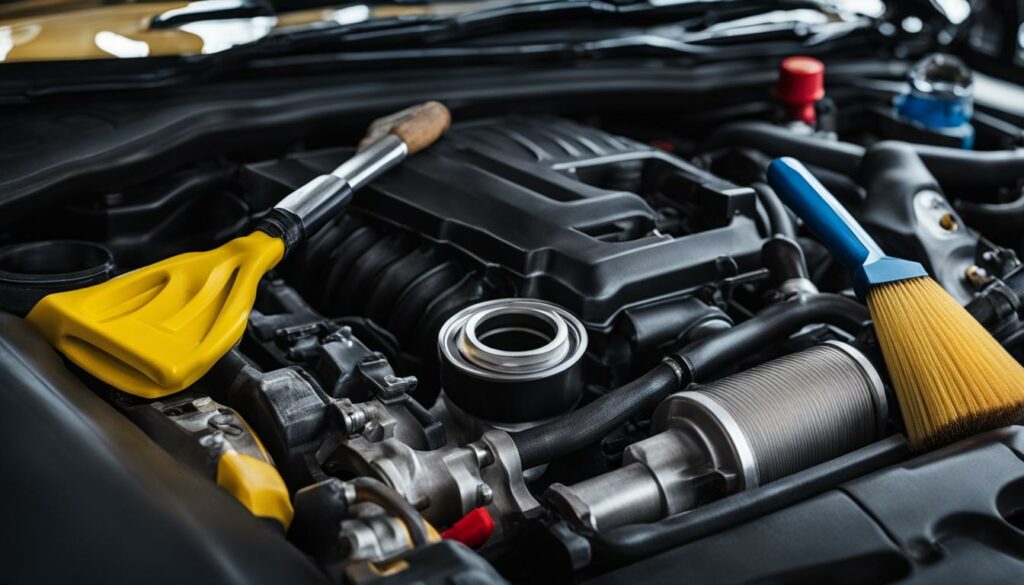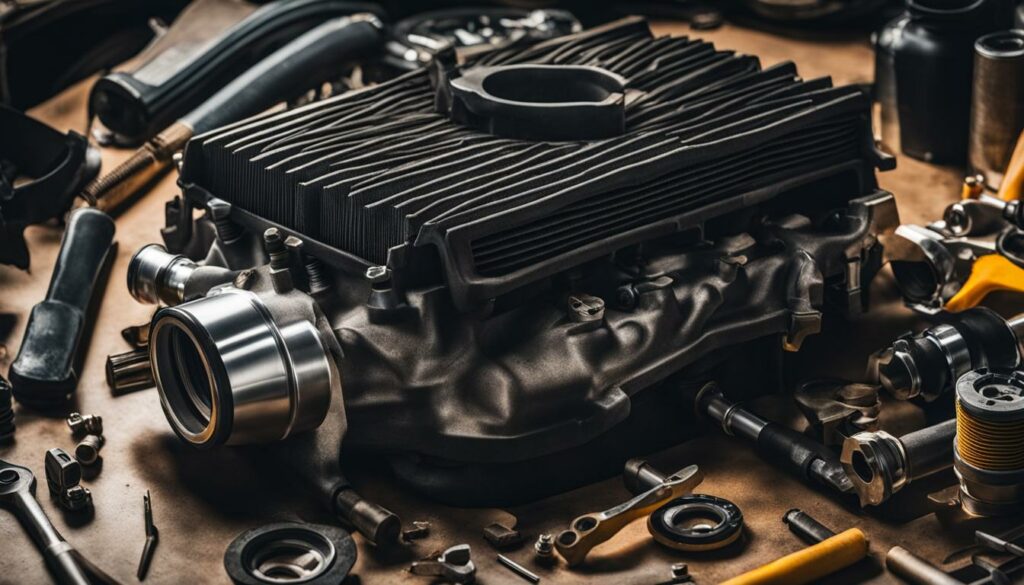Your car engine is the heart of your vehicle, and taking care of it is essential to keep it running smoothly. Whether you’re a new driver or an experienced one, understanding how to take care of your car engine is crucial for your car’s performance and longevity. That’s why we’ve created this comprehensive engine care guide to provide you with expert tips on how to maintain your car engine to the best of your ability.
Key Takeaways:
- Regular maintenance is crucial for keeping your car engine running smoothly.
- Oil changes, air filter maintenance, and spark plug care are essential tasks for effective engine care.
- Proper coolant system maintenance is key to preventing engine overheating.
- Conducting routine inspections and maintenance checks can help you identify potential problems before they become major issues.
- By following the tips and best practices outlined in this guide, you can ensure your car engine performs at its best and remains in optimal condition for years to come.
Understanding the Basics of Car Engine Maintenance
Proper engine maintenance is key to keeping your car running smoothly. But where do you start? Our engine maintenance guide provides a comprehensive checklist of tasks to ensure your car engine is always in optimal condition.
The following engine maintenance tips are essential for every car owner:
- Regular oil changes
- Replacing air filters as needed
- Inspecting and replacing spark plugs
- Maintaining the coolant system
These simple maintenance tasks can go a long way in extending the life of your car engine and preventing costly repairs down the road.
Let’s take a closer look at each of these maintenance tasks and why they are essential:
Regular Oil Changes
Oil changes are perhaps the most important aspect of engine maintenance. Oil lubricates the engine’s moving parts, preventing friction and excessive wear. Over time, oil breaks down, becomes contaminated, and loses its effectiveness. It’s important to follow your car manufacturer’s recommended oil change schedule based on mileage or time intervals.
To check your oil level, use the dipstick under the hood. If the oil is dark and dirty, it’s time for an oil change. You can change the oil yourself or take it to a mechanic.
Air Filter Maintenance
A clean air filter is necessary for proper air flow to the engine, improving its efficiency. The filter prevents debris, dirt, and contaminants from entering the engine. Depending on driving conditions, air filters should be changed every 10,000 to 15,000 miles. Refer to your owner’s manual for your car’s specific recommendations.
Spark Plug Care
Spark plugs ignite the fuel in the engine and provide power to run the car. Over time, they can become corroded or dirty, causing misfires or difficulty starting the engine. Spark plugs should be inspected regularly and replaced every 30,000 to 100,000 miles, depending on your car make and model.
Coolant System Maintenance
The coolant system regulates engine temperature, preventing it from overheating. It’s important to maintain the proper coolant level and to replace old coolant to prevent corrosion and rust buildup. Check the coolant level when the engine is cold and refill as necessary. Refer to your owner’s manual for recommended coolant types and how often to change them.
Regular Oil Changes: Your Engine’s Lifeline
Regular oil changes are a crucial aspect of engine care and should be part of every car owner’s maintenance checklist. Clean oil provides lubrication to the engine, reducing friction and wear and tear on its components. Over time, however, the oil in your car can become dirty and contaminated, reducing its effectiveness and potentially causing damage to the engine.
So how often should you change your car’s oil? The answer to this question can vary depending on the make and model of your vehicle, as well as your driving habits and environment. As a general rule of thumb, however, it is recommended to change your car’s oil every 5,000 to 7,500 miles, or every six months, whichever comes first.
If you’re unsure about how often to change your oil, consult your car’s owner’s manual or speak with a trusted mechanic. Failure to change your oil regularly could result in reduced engine performance and costly repairs down the line.
How to Change Your Car’s Oil
If you’re comfortable performing basic car maintenance tasks, changing your car’s oil can be a straightforward process. Here are the steps to follow:
- Start by gathering the necessary materials, including a new oil filter, oil drain pan, funnel, and the appropriate type and amount of oil for your vehicle.
- Park your car on a level surface and allow the engine to cool down.
- Locate the oil drain plug underneath the car and place the oil drain pan underneath it.
- Use a wrench to loosen and remove the oil drain plug, allowing the old oil to drain out completely.
- Remove the old oil filter using an oil filter wrench, being careful not to spill oil all over the engine or onto the ground.
- Apply a thin layer of new oil to the rubber gasket of the new oil filter and screw it into place.
- Next, insert the funnel into the oil filler hole and slowly pour in the new oil. Be sure not to overfill the engine, as this could cause damage to its components.
- Replace the oil fill cap and run the engine for a few minutes to circulate the new oil throughout the engine.
- Check the oil level using the dipstick and add more oil as needed to achieve the proper level.
- Dispose of the old oil and filter properly, according to your local regulations.
If you’re not comfortable changing your car’s oil yourself, it’s always recommended to have it done by a professional mechanic. An oil change typically costs between $20 and $50 and can be performed quickly and easily at most auto shops.

Air Filter Maintenance: Enhancing Engine Efficiency
A clean air filter is crucial for maintaining your car’s engine efficiency. The air filter prevents harmful debris, dust, and dirt from entering the engine, ensuring optimal performance and reducing the risk of damage over time.
To maintain your air filter, it’s essential to follow these car engine maintenance tips:
- Inspect the air filter regularly: Over time, the air filter may become clogged, inhibiting the proper flow of air to the engine. Inspect the air filter regularly, and check for any signs of wear or damage.
- Clean or replace the air filter: If your air filter is dirty, clean it or replace it regularly to ensure that your engine continues to operate efficiently. Check your owner’s manual for specific instructions on how to clean or replace your air filter.
- Replace the air filter according to the manufacturer’s recommendations: Most car manufacturers recommend replacing the air filter at specific intervals, such as every 12,000 miles or once a year. Follow these recommendations to ensure that your engine stays in top condition.
Regular air filter maintenance can help enhance your engine’s performance, reduce fuel consumption, and extend the life of your vehicle. By following these best practices for car engine upkeep, you can ensure that your car’s engine runs smoothly and efficiently, even as it ages.

Spark Plug Care: Igniting Engine Power
Regular spark plug maintenance is essential for optimal engine performance. Spark plugs are responsible for igniting the fuel in your engine, so keeping them in good condition is crucial.
Here are some car engine maintenance tips for inspecting, cleaning, and replacing your spark plugs:
- Check your vehicle’s owner manual to determine the recommended replacement interval for your spark plugs. Typically, it’s around every 30,000 to 50,000 miles.
- Inspect your spark plugs periodically for signs of wear and tear, such as cracks or deposits of dirt and oil. A good rule of thumb is to check them every time you change your oil or after driving in dusty conditions.
- When cleaning your spark plugs, use a soft wire brush and spark plug cleaner. Avoid using a wire brush that is too stiff, as it can damage the electrodes.
- When replacing your spark plugs, use the recommended type and brand specified in your owner manual. Remove one spark plug at a time to avoid mixing up the ignition wires.
- Use a torque wrench to tighten the new spark plugs to the manufacturer’s recommended torque specification.
By following these engine maintenance checklist tips, you can ensure your spark plugs are functioning correctly and igniting the fuel in your engine efficiently. This will help to prolong the life of your engine and improve vehicle performance.
Remember: If you’re unsure about any aspect of spark plug maintenance, consult a qualified mechanic.
Coolant System Maintenance: Keeping Your Engine Cool
Regularly checking and maintaining your car’s coolant system is crucial for preventing engine overheating, which can cause serious and costly damage. To ensure your engine stays cool and operates at its best, follow these car engine maintenance tips:
- Check coolant levels: When your engine is cold, remove the coolant overflow tank cap and check the coolant level. If it’s below the minimum mark, add the manufacturer’s recommended coolant up to the maximum level.
- Inspect hoses and connections: Look for signs of wear or damage on the hoses and ensure they are tightly connected. Replace any worn or damaged hoses immediately.
- Flush and replace coolant: Over time, coolant can become contaminated and lose effectiveness. Check your car’s manual for the recommended schedule for flushing and replacing the coolant. Typically, coolant should be replaced every two to three years.
By following these simple maintenance tasks, you can keep your engine running smoothly and avoid expensive repairs. Don’t let overheating cause your engine to fail – take care of your coolant system!
Routine Inspections and Maintenance Checks
Regular inspections and maintenance checks are crucial for ensuring the longevity and proper functioning of your car engine. By catching potential issues early on, you can prevent major problems down the line and save yourself from costly repairs.
Belts and Hoses
Inspect the belts and hoses in your engine regularly, looking for any signs of wear or tear. Cracks, frays, or bulges are indications that a replacement is necessary. Consult your car’s manual for the recommended replacement interval.
Fluid Levels
Check your car’s fluid levels regularly, including oil, coolant, brake fluid, and transmission fluid. Low levels may indicate a leak, and neglecting to adequately fill the fluids can cause serious damage to your engine.
Battery
Regularly inspect your car’s battery to ensure that the cables and connections are clean and free of corrosion. If you notice any buildup or damage, clean or replace the battery as necessary.
Exhaust System
Look and listen for any signs of trouble with your car’s exhaust system. Unusual sounds, vibrations, or strange smells can indicate a problem with the muffler, catalytic converter, or other components.
Professional Maintenance
While regular inspections and maintenance checks performed by yourself can help catch potential issues early on, professional maintenance is also essential. Arrange for regular engine tune-ups and inspections with a trusted mechanic to ensure that your car engine is running smoothly and efficiently.
Conclusion
Regular maintenance of your car engine is essential for keeping it in optimal condition. By following the engine care tips and maintenance practices outlined in this guide, you can ensure that your engine runs smoothly and efficiently, prolonging its lifespan and avoiding costly repairs.
Remember to conduct routine inspections and checks, change your oil regularly, maintain your air filter and spark plugs, and keep your coolant system in good condition. These best practices for car engine upkeep will help you catch potential issues before they become major problems, and keep your engine running at its best.
By investing time and attention into your engine’s care, you’ll be able to enjoy the benefits of a reliable and efficient vehicle for years to come. Happy driving!

